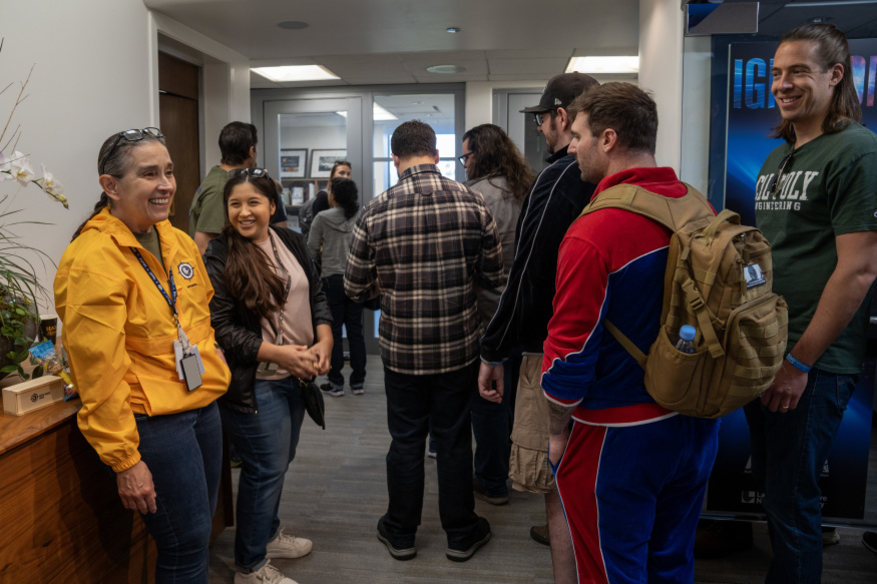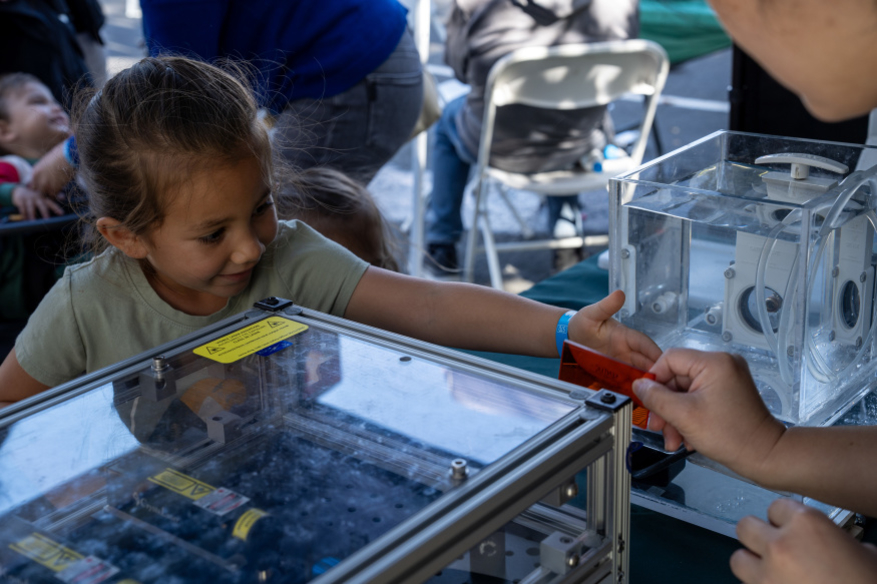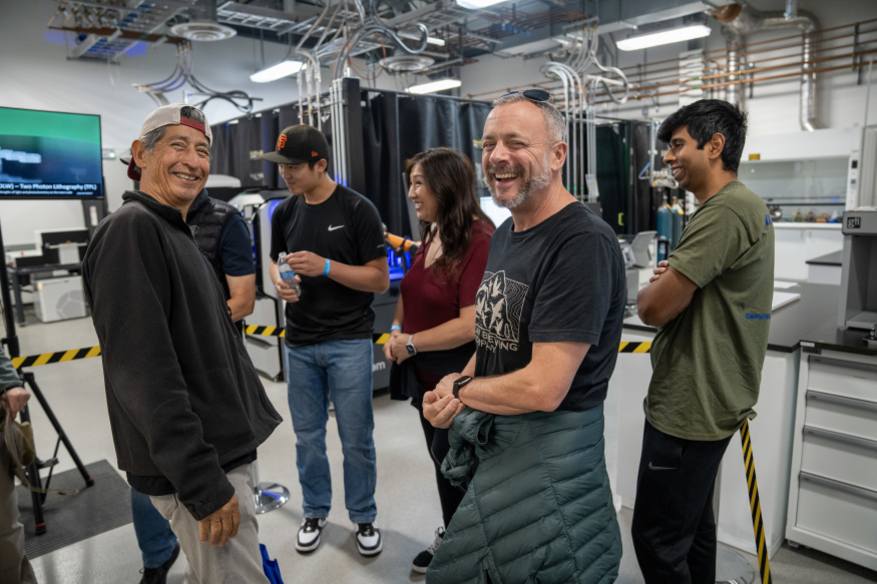LLNL hosts thousands of enthusiastic explorers for Open House 2023
 (Download Image)
(Download Image)
Nearly 19,000 employees and guests gathered for Lawrence Livermore National Laboratory's Open House 2023 on Oct. 21 and 22. Here, parents and children settle in for an up-close presentation called "Fun with Science." (Photos: Blaise Douros and Garry McLeod/LLNL)
Nearly 19,000 employees and guests visited Lawrence Livermore National Laboratory’s Open House 2023 on Oct. 21 and 22: an unprecedented crowd witnessing the Lab’s innovative science and technology up close.
With the theme of “Explore, Discover, Innovate,” every corner of the Lab — from the site of the world’s first fusion ignition reaction to the upcoming home of the world’s most powerful supercomputer — had something special for guests to uncover.
“The Open House has everything,” said Amy Freeman, a guest of Lab contract analyst Karen Hawk. “There are activities for adults and kids, live music, snacks and water stations, candy — and most notably, everyone is so friendly here.”
Computer security specialist Jatinder Singh and his wife Satinder Sandhu were enjoying lunch near Lake Haussman after visiting a few of the many activities and events on offer. “You need at least two days to see everything,” Singh said, having attended both Saturday and Sunday.
Typically, LLNL is closed to the general public, making visitors to most workspaces a true rarity. For employees hosting their friends and family for the first time, Open House was especially meaningful.
“It’s great to be able to show my friends and family where I work,” said Alicia Williams. “It was exciting to be able to bring my wife and kids yesterday, and my friends today. NIF was at the top of our list!”
Eager to see the place where the world’s first ignition reaction occurred, lines of people waiting for tours snaked through the plaza in front of the National Ignition Facility throughout much of the weekend. For NIF, Open House was a rare public opportunity to show off after the historic Dec. 5, 2022 experiment that found its way into news outlets all over the world. After walking past the vast laser bays and target chamber areas, tour attendees had the chance to ask a variety of NIF scientists questions about fusion power plants, target fabrication and lots more.
“I just enjoy the energy the staff brings to entertain and educate us,” said Annalisa Jensen. “I was surprised to see so much.”
“I appreciate all the people answering our questions, even the ones we feel silly about,” said Willow Weibel.
Not far from NIF was the BBQ Bonanza, where food trucks clustered together to serve everything from miniature doughnuts to hot dogs. As guests enjoyed their lunches, Laboratory Director Kim Budil spoke about two of the Lab’s founders: Nobel laureate Ernest Lawrence, who advocated for “big team science;” and renowned physicist Edward Teller, who pushed for “big technical ambition.”
“That’s still how we work today,” Budil said. “We are super-excited to show you our Lab.”
Janis Parenti, manager of the National Nuclear Security Administration’s Livermore office, echoed Budil. “We couldn’t accomplish all the things we do without the dedicated workforce that gets the job done,” she said. “Take your families around, show them what you do — and what we all do here together.”
Not long after, a cluster of kids rushed forward to join Budil, Parenti and LLNL’s Associate Director for Business Lisa Belk for “Fun With Science.” Grandparents at a nearby table remarked on the kids’ smiles as Belk prepared Elephant Toothpaste. It was Parenti’s job to choose the colors for the chemical reaction, but she asked the kids instead; they chose blue and green, “which are excellent colors for Elephant Toothpaste,” Parenti said.
The STEM Expedition was around the corner, where children also could take part in 19 booths full of hands-on science and technology. There were holograms, 3D printers, homemade rockets, and an aluminum foil raft challenge, where participants had to see how many pennies they could place in the raft before it sank.
“My kids have had such a good time at the online coding games booth and advanced manufacturing on the holodeck booth,” said materials scientist Liang-Yu Chen. “My personal favorite was the liquid ice cream nitrogen.”
Events were concentrated in a handful of areas around the one-square-mile Laboratory site, connected by shuttle buses that ran frequently throughout the day. Across the lake, around the corner from one of many “photo booths,” crowds were gathering for tours of the Lab’s high-performance computers. After visiting the powerful Sierra system, attendees came into view of the under-construction El Capitan exascale machine, slated to become the world’s most powerful supercomputer when it’s finished next year. Experts from LLNL’s Computing Directorate were on-hand to answer questions. For staff based in the secure building, it was a long-awaited chance to show off their workspaces.
Elementary-school aged Samantha, whose father works in the Computing building, always imagined that her dad just worked “in a room with a computer.” During Open House, she announced that there had been a correction: He, in fact, works “in a room with two computers.”
In another corner of the one-square-mile site, guests were watching a massive video screen in the main control room of the National Atmospheric Release Advisory Center, learning about how NARAC helped predict where dangerous radiation would go after nuclear accidents such as Three Mile Island and Fukushima. One of NARAC operations scientist Jessica Cruz’s guests said it was cool to see her in the video, but Cruz herself was proud of something else.
“These kids know me as their carpool driver,” she said, pointing to her guests: her son, his football teammates and their parents. “But it’s great for them to see me — a woman — in connection with all the cool science that’s going on.” She noted that, as a single mom living in Oakland, “the only way I can work and do my mission is because these families drive my kids around.”
Across the parking lot at the Global Security Roadshow, Katheryn Stewart was perusing booths detailing LLNL’s work in forensic science, homeland security and nuclear threat reduction, among others. “It’s like a city,” she said. “There’s a million people here doing more than just making weapons.”
For Alexander Pinto, a physicist working on the Advanced Sources and Detectors Scorpius linear accelerator project, Open House was a rare opportunity not only to talk about his work, but explain it in layman’s terms. He stood behind a long tube with four triggers attached. If each trigger were pressed at just the right time, the ping-pong ball inside the tube would shoot through fast enough to hit a target. But one kid couldn’t help but be trigger-happy.
“I’m going to tell you what to do, man,” Pinto said. “It’s going to be awesome.” After a few tries, they finally managed to hit the target, demonstrating how a linear accelerator moves its atoms fast enough to “smash” them.
“I got out to every corner of the Lab and talked to so many people,” Budil said. “They all expressed gratitude for the opportunity to share this part of their lives with friends and family and awe at the incredible work going on across our site.”
As thousands of visitors filed toward the parking lot at the end of the day, there were a few who just weren’t ready to leave. Computational engineer Steven Alves and his family were enjoying the Quest Science Center, who set up an exhibit at LLNL’s Livermore Valley Open Campus. All day long, Quest had been launching paper rockets and running an artificial intelligence photo booth, but now they were focused on picking up foam blocks with remote-control cars. Seven-year-old Liam was the room’s resident pro.
"Want me to teach you how to do it?” he asked his mom. “It’s actually really hard but I’ve gotten able to do this easily.”
Liam had been all over the Lab throughout the day: he said he set the record for pennies loaded onto the aluminum raft. But for his grandmother, Anna Wong, there was still more to see.
“We’re fascinated, that’s why we’re sticking around,” she said. “We’re just barely scratching the surface, I’m sure, but it’s really fascinating.”
Materials engineer Garrett Law, who brought his teenage sons on-site for the first time, reflected on how meaningful it was for them to finally shake hands with the people he’d been working with at the Lab for years.
“I get to talk so rarely about what I do,” he said. “It’s not too often you get to see this stuff anywhere in the world.”
-Ben Kennedy and Maryem Torabi
Contact
Ben Kennedy[email protected]
925-424-5328
Related Links
Open House 2023 Flickr galleryOpen House 2023 on YouTube
Tags
ASCScience
Community Outreach
Visiting
Featured Articles











